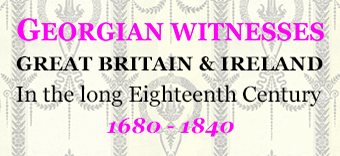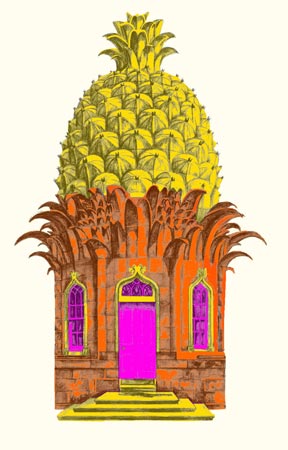Georgian Witnesses
13 / GEORGIAN HOUSES, GARDENS AND FOLLIES, TESTIFYING TO ELITE GRANDEUR AND WEALTH
CONTEXT
The elite of interconnected aristocratic and plutocratic families throughout the three kingdoms spent on all sorts of conspicuous consumption (clothes, jewels, furniture, carriages) but among their major outlays were investments in country houses, in ornamental and landscaped gardens and, for some, in monumental showpieces (also termed ‘follies’). Here are nine examples chosen to show the diversity within each category: country houses; gardens; and monumental showpieces (‘follies’).
NINE COUNTRY HOUSES
[NB many are also famed for their Gardens]
13.1 Stowe House, Buckingham, Buckinghamshire MK18 5EQ, England. This palatial building was constructed in several phases: from 1677 – 83 the central block was built; then in the 1720s the frontages were upgraded, including the creation of the Ionic North Portico by the architect John Vanbrugh; and then further additions followed in the 1770s, including the twin
flanking colonnades.
The Grade-1 listed House and its stunning interior is now owned by the Stowe Preservation Trust and occupied by Stowe Public (independent) School, but visitors are regularly admitted at specific times, while the magnificent gardens are owned by the National Trust, the Trusts between them meeting the costs of restoration and maintenance
13.2 Petworth House, Petworth, West Sussex GU28 9LR, England. Constructed in 1688 – 93 on the site of an earlier manor house for the ‘proud’ 6th Duke of Somerset and his wife Elizabeth Percy, the heir to the Percy family fortune, the grand three-storeyed house was built in the new Baroque style, in local freestone ashlar ornamented by Portland stone, with a mansard roof of grey slates, and a notably long (317 feet or 96.6 metres) West frontage. Later additions included the North Gallery to house paintings (1820) and a remodelling of the S-E end by Anthony Salvin from 1869 – 72. The National Trust now cares for the Grade 1-listed House plus its superb art collection, its Grinling Gibbons wood carvings, and its landscaped deer-park.
13.3 Castletown House, Celbridge, County Kildare W23 V9h3, Ireland. Castletown is an elegant Palladian country house, constructed in 1722 for William Conolly, Speaker of the Irish House of Commons. It contains notably grand reception rooms and a celebrated 80-foot (24 metres) Long Gallery. Some of the estate was sold for development, controversially, and, after various twists and turns, the House and its remaining estate were transferred to the Irish Office of Works. The IOW has renovated the property and uses it for civic projects, including, in collaboration with Maynooth University, an Archive and Research Centre for the history of Irish landed estates.
13.4 Bowood House, between Calne and Chippenham, Wiltshire SN11 0LZ, England. The main house, which is home to the Petty-Fitzmaurice family, Marquesses of Lansdowne, has had an architecturally chequered history: the first edifice was constructed in c.1725 but was extended and embellished in the 1760s, with the addition of interiors by architect Robert Adam, most notably the long Drawing Room. The oldest part of the residence, the Big House, was demolished in 1756, when the Adam Room was purchased and removed to insurance brokers Lloyds of London, where it remains a showcase room; and the Georgian Portico, designed by Adam in 1766, was purchased and reconstructed at Roath Court, a nineteenth-century villa in Roath, situated north-east of Cardiff City centre.
Nonetheless, the remaining mansion is still large, with grand rooms and furnishings in the front wing open to the public; and showcase gardens, designed by Capability Brown. The Bowood Laboratory was the location where in 1774 Joseph Priestley, then tutor to the Marquess’s two sons, identified oxygen – a feat commemorated in 2000 by a National Historical Chemical Landmark award from the American Chemical Society.
13.5 Duff House, Banff, near Aberdeen, Aberdeenshire AB45 3SX, Scotland. This imposing early Georgian house was built between 1735 and 1749, to designs by William Adam for William Duff, 1st Earl Fife. Its square building has a façade of dressed stone (ashlar), impressive corner towers, and an entrance staircase, its two branches sweeping up to the main front entrance. There were also plans for flanking pavilions but those were halted when the architect and owner litigated over costs.
The House, a category-A listed building, is now in the care of Historic Environment Scotland, and features not only impressive gardens but also a significant art collection, shown as part of the National Galleries
of Scotland.
13.6 Rousham House, Rousham, Oxfordshire OX25 4QU, England. The core of this substantial country house was built c.1635 but in the 1740s was extensively remodelled in a free ‘Gothic’ style by architect William Kent who added crenellated battlements and two
additional wings.
Rousham House, which has remained continuously in the ownership of the Cottrell-Dormer family, is open to visitors by appointment, while the charming eighteenth-century gardens are open to the public daily.
13.7 Inveraray Castle, near Inveraray, Argyllshire PA32 8XE, Western Scotland. This massive neo-baronial castle is home to the dukes of Argyll, chiefs of the Clan Campbell. Its foundation stone was laid in 1746, making it one of the first buildings in the UK to be planned in the new retro-style known as Gothic Revival; but its first incarnation was not completed until the 1770s. The project included the removal of the Inveraray estate village to a location further away from the Castle. In the 1870s, the original two storeys were augmented with a third storey with pitched roof and dormer windows on all four wings of the house, and conical roofs were added to the conical corner towers.
A serious fire in 1976 was followed by substantial renovation; and the house, excluding the Argyll family’s private apartment, is now open
to the public
13.8 Wedderburn Castle, near Duns, Berwickshire TD11 3LT, Scotland. This imposing country seat was designed and constructed in 1771 – 5 by the architectural brothers Robert and James Adam for the Wedderburn family, building upon the site of an earlier Border castle. The resultant compactly massive edifice, with its battlemented roof-line and notable corner towers, is highly characteristic of the ‘Adam Castle’ style.
The category A-listed venue is now available for hire for up-market weddings, receptions and house parties, with bedrooms available in both the Castle and its converted Barns; the harmonious interior includes a spectacular ballroom.
13.9 Berrington Hall, three miles north of Leominster, Herefordshire HR6 0DW, England. This substantial country house was designed in 1778 – 81, to replace an older residence, by architect Henry Holland, who stuck firmly to neo-classical Palladian style, including a colonnaded West Front. It was built for Thomas Harley, a banker, government contractor, and former Lord Mayor of London, who left the property to his daughter. The Hall is not as large as some of the most palatial mansions, but is aptly described as ‘Georgian grandeur on a human scale’. With its collection of furnishings, paintings and historic costumes, the Hall and its landscaped gardens are now owned by the National Trust.
NINE LONG-EIGHTEENTH-CENTURY GARDENS
13.10 Hampton Court Palace Gardens, Hampton Court, East Molesey, Surrey KT8 9HB, England.
[See also Witnesses-9.23]
The Gardens, tended by Historic Royal Palaces, have extensive acres of parkland; a hedge maze (commissioned c.1700); the Great Vine (hothouse-planted in 1768 by Capability Brown) and the formal Privy or Dutch Garden (commissioned by William III in 1701; reconstructed 1995). A magnificent ironwork screen, which divides the Privy Garden from the River Thames, was designed by a Huguenot master iron-worker in 1690 and is named after him as the
Tijou Screen.
13.11 Westbury Court Garden, Westbury-on-Severn, Gloucestershire GL14 1PD, England. This rare surviving example of a Dutch-style Water Garden was laid out in 1696-1705, and, unusually, not revamped in the course of the eighteenth century into the picturesque style that was favoured by Capability Brown and his followers.
Located in the low-lying water meadows by the Severn, the Garden features the Dutch water garden; canals; ponds; a walled garden and an orchard. At one point in 1960, it was on the brink of being built over, but it was saved and the National Trust now works to restore the Grade 2-listed Garden to how it would have appeared at its best in 1720.
13.12 Dawyck Botanic Garden and Arboretum, at Stobo village, west of Peebles, Upper Tweed Valley EH45 9JU, Scotland. The gardens at Dawyck House wereoriginally planted by the family in the seventeenth century and augmented by plant-hunting expeditions in
the eighteenth.
Eventually the Garden and Arboretum were given to The Royal Botanic Garden (while the House remains privately owned). Three of the 11 heritage trees of Scotland in the Scottish Borders are found here, one being the Dawyck Larch,
planted 1725.
13.13 Stourhead Garden, at Stourhead, Wiltshire BA12 6QF, England. Between 1744 and 1780, this world-famous garden was spread around artificial lakes, formed by damming the headwaters of the Stour. The garden was planted to reflect different moods, and many eye-catching monuments and special features were also installed within the gardens to round out and complement the views.
The Garden, designated Grade I in the Register of Historic Parks & Gardens, is part-owned by the National Trust.
13.14 Wimpole Hall Gardens, Wimpole, near Cambridge, Cambridgeshire SG8 0BW, England. The Gardens were landscaped by various landscape designers, including notably (1767) Lancelot ‘Capability’ Brown.
The North Park features rolling woodland, with artificial lakes and items of visual interest, like the Gothic Tower or Folly (1768). There is also a Home Farm (established 1792) and an eighteenth-century walled garden.
13.15 Castle Hill Gardens, Filleigh. Devonshire, England. Situated on the southern edge of Exmoor, these Gardens provide a ‘spectacular’ eighteenth-century landscape, studded with statues and temples, as well as a Sham Castle (c.1746) and a hilltop Triumphal Arch (1730;
rebuilt 1961).
The Grade 1 Gardens (according to the National Register) are privately owned; but open for viewing at specific times.
13.16 Piercefield Park Gardens, near Chepstow, Monmouthshire NP16 5DS, Wales. Piercefield House was built as a Palladian country house in the later eighteenth century and the Gardens landscaped in picturesque style by a follower of Capability Brown. Woodland walks were laid out, items of visual interest were added, including a druid’s temple and a giant’s cave; and clifftop viewpoints over the River
Wye established.
The Park remains a Grade 1-listed historic landscape; but the dilapidated Piercefield House remains in need of salvation.
13.17 Castle Ward Gardens, near Strangford, County Down BT30 7BA, Northern Ireland, constitute one of the best preserved examples of a late eighteenth-century landscape park in Ireland.
Visitors to this National Trust property can walk through extensive trails through park- and wood-land, and visit the walled garden (1830) and Victorian sunken
garden (restored).
13.18 Hafod Uchtryd Gardens, in the Ystwyth Valley, Ceredigion SY25 6DX, Wales. The estate’s ‘golden years’ dated from 1790 to the 1810s, when the estate owner, Col. Thomas Johnes, planted approx. three million trees, with European Larch and Scots Pine on the higher ground, and oak and beech trees below; and made other improvements. Much later, the estate fell into disarray and the house was demolished.
But the Gardens are now owned by National Resources Wales, which, with the Hafod Trust, raised funds for their upkeep.
NINE MONUMENTS AND/OR FOLLIES
13.19 Conolly’s Folly (1740), adjoining Castletown estate, near Maynooth, County Kildare, Ireland. It takes the form of an obelisk aloft on a giant arcaded structure, the whole reaching a height of 138 feet (42 metres); and was commissioned by the local landowner as a make-work project for the local population during a local famine in 1740/1. It is now a National Monument.
13.20 The Wonderful Barn (1743), adjoining Castletown estate, near Maynooth, County Kildare, Ireland. It takes the unusual form of a stone-built corkscrew building, with the stairs winding around the structure’s exterior, rising to a height of 72 feet (22 metres); it was also commissioned by the local landowner to provide work for the local population and to act as a reserve community granary.
13.21 Perrott’s Folly, also known as The Observatory (1758), Rotton Park, Edgbaston, Birmingham B16 9AL, England. It takes the form of a very tall, thin brick-built buttressed tower, standing 96 feet (29 metres) high. It has a Grade II listing. Originally built as an observation tower by John Perrot, it was used as a weather observatory from 1884-1979, and is now managed by a charitable trust.
It has been conjectured that its towering imagery may later have stirred the creative imagination of the writer J.R.R. Tolkien (1892 – 1973), who as a child lived nearby and whose fantastic tales feature brooding dark towers.
13.22 The Dunmore Pineapple (1761 – 77), in Dunmore Park, near Airth, Stirlingshire FK2 8LS, Central Scotland. Considered ‘the most bizarre building in Scotland’, it was commissioned by the local landowner and constitutes a two-storeyed brick summerhouse topped by a stone cupola carved like a giant pineapple, which itself is 45 feet (13.7 metres) high.
The building is now cared for by Landmark Trust, which rents it out for holiday accommodation.
13.23 Sham Castle (1762), Claverton Down, overlooking City of Bath, Somerset BA2 7JY, England. It takes the form of an impressive stone wall with high central arch, embellished with towers and turrets, mimicking the facade of a castle – being one of numerous mock medieval castles built at the mid-century.
It was commissioned by local entrepreneur and philanthropist, Ralph Allen, for its visual impact on the skyline; today, the listed monument’s front face is illuminated at night.
13.24 The Fyrish Monument (1782), on Fyrish Hill, Fyrish, Evanton, Easter Ross IV16 9XL, Scotland. The structure evokes the Gate of Negapatam (now Nagapattinam) in Madras, India, which the local landowner, Sir Hector Munro, seized for the British in 1781.
The hilltop Monument is situated at an elevation of 1,468 feet (447.5m) and is visited for a good hill climb and spectacular views. (See Witnesses-2.15 for fuller details)
13.25 Broadway Tower, also known as Broadway Folly (1794), Broadway Hill, Broadway, Worcestershire WR12 7LB, England. It was designed by James Wyatt as a tall but narrow ‘Saxon’ castle, reaching the height of 65 feet (20 metres), and visible for miles around, as it stands on a high point in the Cotswolds (elev. just over 1000 feet), which was traditionally used as a beacon hill.
13.26 Beckford’s Tower, formerly known as Landsdown Tower (1827), Lansdown Hill, outside Bath, Somerset BA1 9BH, England. Built to Italianate designs, for William Thomas Beckford (1760 – 1844), the wealthy novelist, art collector, and architectural patron, it was initially used as a library and retreat,
with wide views from the topmost belvedere (height 154 feet
(47 metres)).
The listed building is now open as the Beckford Museum, which acknowledges and debates the source of the Beckford family wealth from West Indian sugar plantations, worked by enslaved labour.
13.27 Clavell Tower, also known as Clavell Folly (c.1830) is located on clifftop near Kimmeridge Bay, Dorset BH20 5PF, England. It was built by a local landowner as observatory and folly, and takes the form of a brick- and stonebuilt round tower (height c.35 feet (over 10 metres)), with an encircling Tuscan colonnade at ground floor level. After a period of decay, the building has been renovated and also relocated inland, away from the crumbling cliffs.
The Landmark Trust rents Clavell Tower for holiday accommodation.




